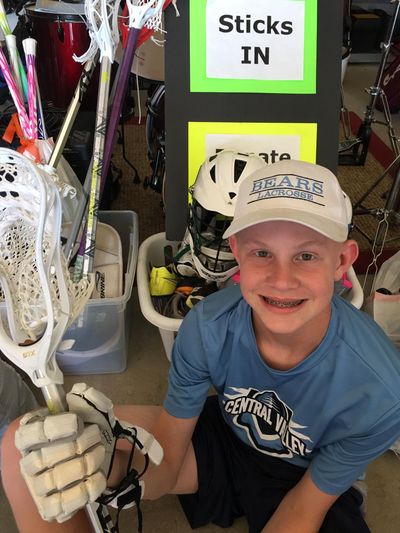Spokane Valley teen blends lacrosse and budding business

Andrew Gibbons and his dad went looking for a new sport.
“I was doing Boy Scouts and I was thinking that I wanted to do something different. So my dad did some looking and he came back with three options: baseball, soccer and lacrosse,” he explains. “One of our neighbors played lacrosse at Gonzaga Prep and I thought it looked pretty cool, so I chose lacrosse.
“I loved it. But I did carry my stick upside down for the first half of my first practice. It takes a while to really get the hang of it. I would say it took me the first half of the season before I really got the hang of how to play.”
Now 14 and preparing for his freshman year at Central Valley High School, Gibbons’ passion for the game has grown to the point where he plays on a select team in the summer and he’s eager to join the strong lacrosse program associated with CV next spring.
And he’s turned his love of the game into a business.
“I saw a business movie and I thought it was interesting; I’ve been thinking about going into business,” he said. “My mom runs a nonprofit business. I talked with her, and we came up with the idea of collecting lacrosse gear for other kids. It sounded like it would make for a good, nonprofit business. There’s nothing like it out there.”
So Gibbons set out the way you’re supposed to if you want to start a business. He drafted a business plan, put together a marketing strategy and talked to the bank about a loan.
And he set about collecting used equipment for players of all ages.
“I discovered that asking people for their old equipment was a lot like asking people for money,” he laughed. “But I talked to the president of Spokane Youth Lacrosse, and we sent out an email asking people for their old equipment. A lot of the equipment I get is from parents who have kids playing in the league.
“And we got some equipment donated to us from U.S. Lacrosse.”
His growing collection of gear, for both boys and girls, is made up of equipment other players have outgrown or have upgraded.
Lacrosse is one of those sports where the initial investment in equipment can be prohibitive.
“When I started out I got some used equipment,” he said. “I got my shoulder pads, elbow pads and stick for free. I got my gloves for super cheap, and my helmet was about $100, maybe $150. I kind of lucked out.
“Some of my teammates ended up buying everything new. When you looked at them it was like they came right out of the catalog.”
That kind of investment can run from about $600 to over $1,000, he said. A helmet, he said, accounts for about a quarter of that investment.
“The stick I use now costs about $200,” he said. “My shoulder pads run about $100. Gloves can be pricey. On top of all that you need cleats and a mouthpiece, too. I’ve had some donations of cleats already, too.”
Being able to provide new players with free equipment to get them started is his way of helping to grow a sport that is already seeing a solid growth curve – for both boys and girls.
“I want to make sure that more kids can play lacrosse if they want to,” he said. “I want to see the sport grow.”
And he wants to see his business grow and expand, so that the sport can do the same.
“Eventually I want to start a summer camp for young kids who want to learn the game,” he said. “I want to be able to offer them scholarships.”
Gibbons has set up an Instagram account, @sticks_in, and a Facebook account is coming soon. But the easiest way to find him, he said, is to check out the Spokane Youth Lacrosse web page, www.spokaneyouthlacrosse.com, and click on the Swap Shop page.
While equipment is required, Gibbons said there is one other thing a player needs to be successful at lacrosse.
“What you really need is speed,” he said. “You don’t need long-distance speed, but you have to be able to run in short bursts up and down the field. That’s the way it works. You make six or seven runs down the field and then you get subbed out to catch your breath. You need to have speed in bursts.”